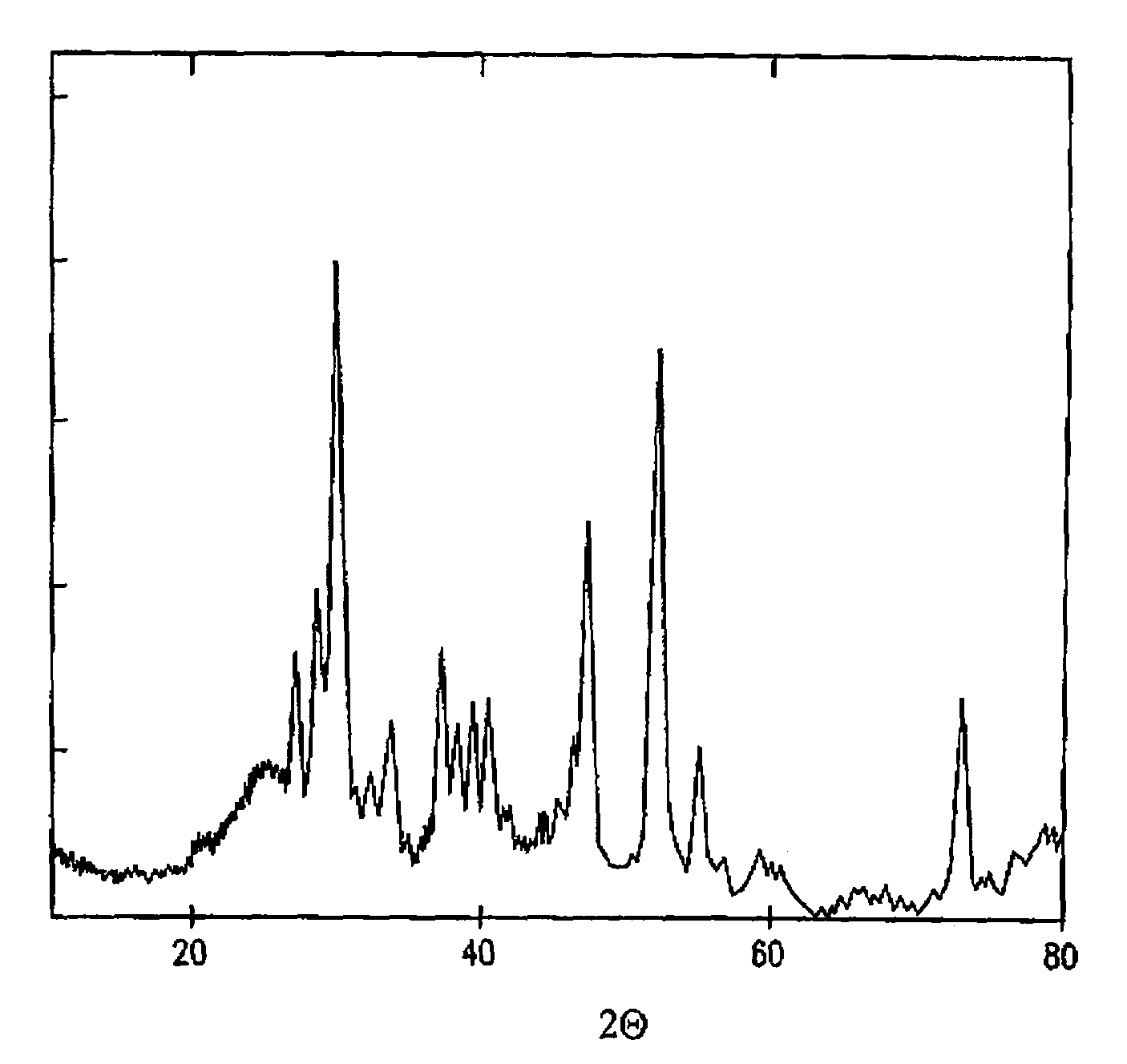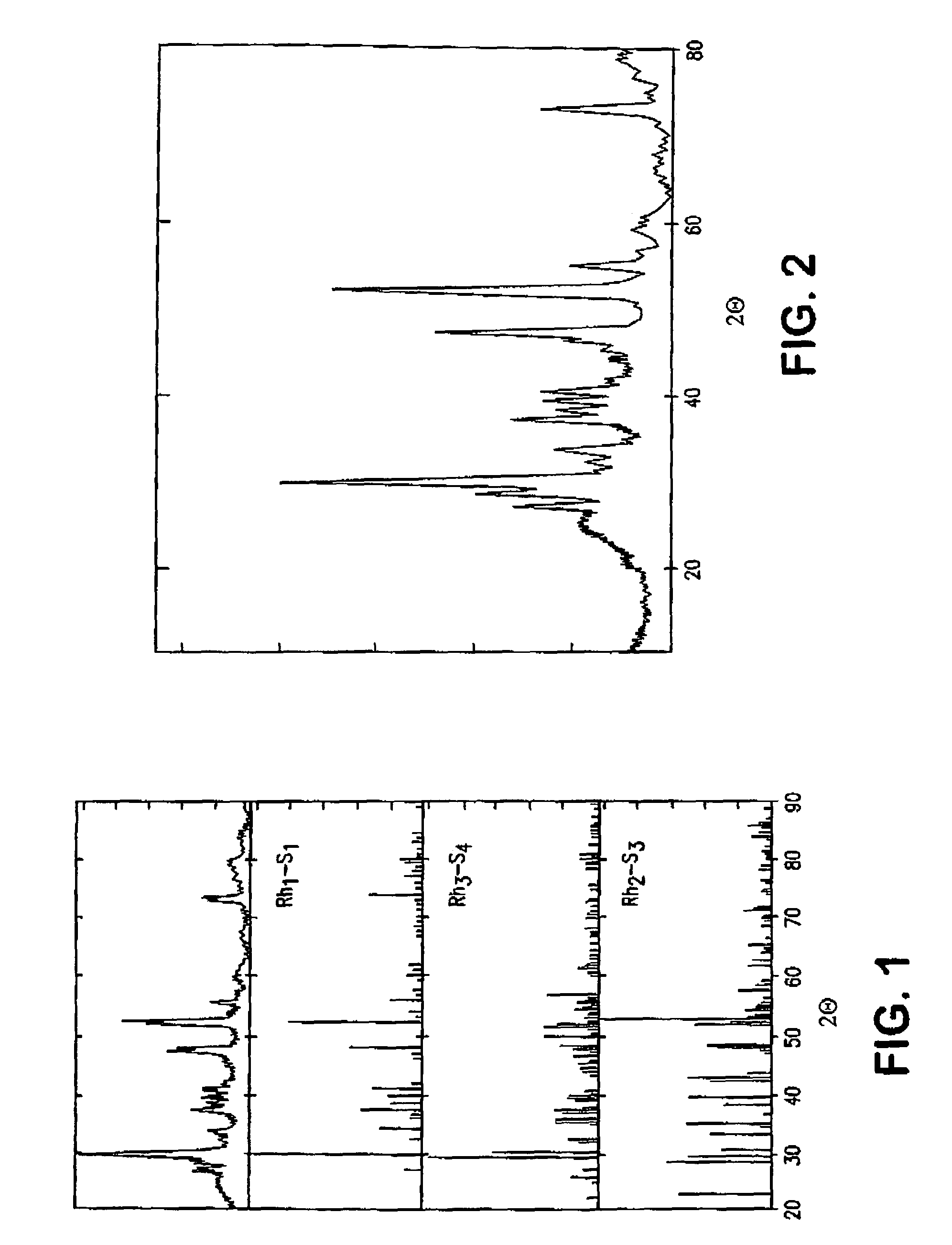Catalyst for electrochemical reduction of oxygen
a catalyst and oxygen technology, applied in the field of catalysts, can solve the problems of still presenting some limitations in terms of activity and stability, formation of less stable phases such as zerovalent metals, metal oxides and non-stoichiometric perovskites, and leakage of noble metals still detectabl
- Summary
- Abstract
- Description
- Claims
- Application Information
AI Technical Summary
Benefits of technology
Problems solved by technology
Method used
Image
Examples
example 1
[0031]Described herein is a method to precipitate a rhodium sulphide single crystalline phase on carbon according to the method of the invention; precipitation reactions of other noble metal sulphide catalysts (such as the sulphides of ruthenium, platinum, palladium or iridium) only require minor adjustments that can be easily derived by one skilled in the art.[0032]7.62 g of RhCl3.H2O were dissolved in 1 l of deionised water, and the solution was refluxed.[0033]7 g of Vulcan XC 72-R high surface area carbon black from Cabot Corporation were added to the solution, and the mix was sonicated for 1 hour at 40° C.[0034]8.64 g of (NH4)2S2O3 were diluted in 60 ml of deionised water, after which a pH of 7.64 was determined (sulphur source).[0035]4.14 g of NaBH4 were diluted into 60 ml of deionised water (reducing agent).
[0036]The rhodium / Vulcan solution was kept at room temperature and stirred vigorously while monitoring the pH. In this case, the sulphur source and reducing agent solutions...
example 2
[0043]A ruthenium cobalt ternary sulphide (3:1) catalyst was prepared in a similar manner as the one of Example 1, the difference being that the thionic reagent is now part of the metal ion solution, thus the metathesis reaction occurs in-situ on the metal ion sites.[0044]7.62 g of RuCl3.xH2O were dissolved in 1 l of deionised water, and the solution was refluxed.[0045]2.46 g of CoCl2.xH2O were also added to the Ru containing solution and refluxed as above. 8 g of Vulcan XC72-R high surface area carbon black from Cabot Corporation were added to the solution, and the mix was sonicated for 1 hour at 40° C.[0046]17.5 g of (NH4)2S2O3 were diluted in 100 ml of deionised water, after which a pH of 7.72 was determined, then added to the catalyst / Vulcan solution (sulphur source).[0047]6.54 g of NaBH4 were diluted into 100 ml of deionised water (reducing agent).
[0048]The sulphur source solution containing ruthenium, cobalt and Vulcan carbon black was kept at room temperature and stirred vigo...
example 3
[0052]Different samples of the catalysts of Examples 1 and 2 were prepared, mixed to a PTFE dispersion and incorporated into conventional flow-through gas diffusion electrode structures on carbon cloth. All the electrodes were compared to a standard state-of-the-art supported RhxSy electrode for hydrochloric acid electrolysis, according to the teaching of U.S. Pat. Nos. 6,149,782 and 6,967,185 (Sample 0). Such electrodes were tested as oxygen-consuming cathodes in a 50 cm2 active area laboratory cell against a standard anode, making use of a by-product aqueous hydrochloric acid solution from an isocyanate plant. The overall cell voltage was recorded at two different current densities, namely 3 and 6 kA / m2, and the corresponding values are reported in Table 1.
[0053]
Sample IDvoltage at 3 kA / m2voltage at 6 kA / m201.161.45Example 11.101.37Example 21.111.41
[0054]All of the tested electrode samples showed an excellent catalytic activity, resulting in a sensible voltage decrease with respec...
PUM
| Property | Measurement | Unit |
|---|---|---|
| temperature | aaaaa | aaaaa |
| reduction potential | aaaaa | aaaaa |
| temperatures | aaaaa | aaaaa |
Abstract
Description
Claims
Application Information
 Login to View More
Login to View More - R&D
- Intellectual Property
- Life Sciences
- Materials
- Tech Scout
- Unparalleled Data Quality
- Higher Quality Content
- 60% Fewer Hallucinations
Browse by: Latest US Patents, China's latest patents, Technical Efficacy Thesaurus, Application Domain, Technology Topic, Popular Technical Reports.
© 2025 PatSnap. All rights reserved.Legal|Privacy policy|Modern Slavery Act Transparency Statement|Sitemap|About US| Contact US: help@patsnap.com


